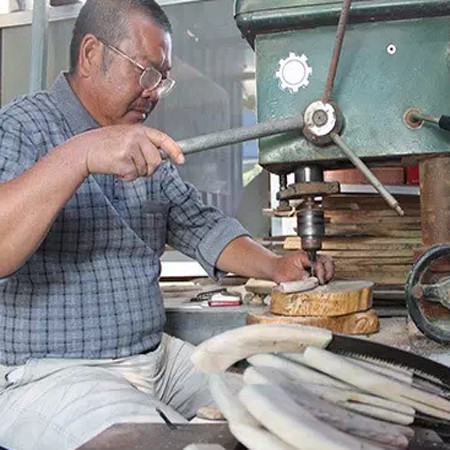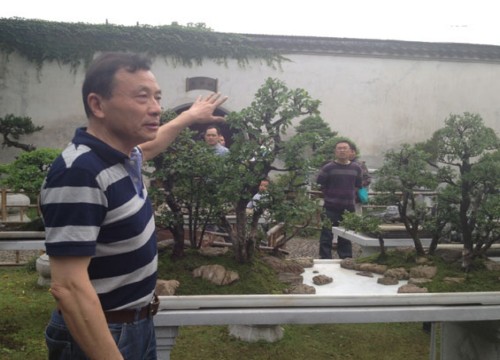Production steps of flood and drought bonsai
Bonsai paintings of flood and drought are full-bodied, blend of feelings and scenes, and enjoy both elegance and popularity, which is a form loved by the broad masses of people. To make flood and drought bonsai, we should not only have the basic skills of processing tree bonsai, but also have the experience of making landscape bonsai, but also require the author to have higher cultural and artistic accomplishment, only chest culvert and hilly, good at aesthetic, and rich practical experience, in order to create excellent works.
1. Select trees
In the flood and drought bonsai, trees have a relatively prominent position. The shape and charm of trees have an important influence on the composition of scenery and freehand brushwork. Trees in bonsai can be planted alone, co-planted or clustered. Isolated trees require a relatively perfect shape; co-planted and clump-planted trees require a unified style, which can be divided into size, height, primary and secondary. As the flood and drought bonsai shows the natural scenery, the posture of the trees should be natural and should not be affected. The selected trees, preferably cultivated in pots, have mature roots and are easy to survive when implanted into flood and drought bonsai.
2. Stone selection
In flood and drought bonsai, mountains and rocks are not only the companions of trees, but also best reflect the scenery and geomorphological features of the water surface. Make flood and drought bonsai mostly use hard stone, because of its good texture, and the separation of flood and drought will not be permeable. The commonly used hard stones are Yingde stone, tortoise stone, Xuan stone, stalagmite and so on. Cancellous stone such as sand accumulation stone, Reed tube stone and so on can also be used as flood and drought bonsai, but because the stone has fine holes to permeate water, it needs to be treated as anti-leakage when separating flood and drought. Different kinds of stone have different texture, shape, texture and color, and what kind of stone should be chosen depends on the content of the work. In the same kind of stone, there are great changes in texture and color, so special attention should be paid to the harmony of quality, shape, grain and color when selecting stones. The stones used for sloping banks and water surfaces should be cut flat so that they are close to the basin surface when they are placed in the basin. Ore cutting machine can be used to cut stone.
3. Selection of basin
The production of flood and drought bonsai should be made of a shallow white marble basin with no hole at the bottom, which can store water and facilitate the performance of the waterscape. Shallow basin, can highlight the twists and turns of the waterline, is the so-called "mountains live because of water, water changes because of mountains." The plain color of the basin, like a piece of white paper, can set off the tree stone composition "painting" incisively and vividly. The shape of the basin is rectangular, oval, waist circle is more suitable, square, circle is less used, special-shaped basin is not enough.
4. Arrange the trees
The tree materials of flood and drought bonsai must be processed and arranged to make them have a beautiful posture and meet the requirements of landscaping. The combination of flat binding and pruning can be adopted in the processing, which should consider not only the posture and charm of the trees themselves, but also the needs of composition and layout. If multiple trees are co-planted or planted in clusters, it is necessary to sort out the relationship between master and subordinate, contending for concessions, and so on. When the root system affects the planting, the root system should be pruned or tied properly so that it can be easily planted in the basin.
5. Try to make the layout
Layout is an important part of making flood and drought bonsai. First put the selected trees in the appropriate position in the basin, and then put the rocks to design a zigzag slope. In the trial release process, while observing, while adjusting, so that the tree and stone coordination, the layout is natural and full of artistic conception. The common layout forms are Shuiyang type, jianghu type, Xijian type and so on. After the layout is determined, the position of the rocks can be drawn in the basin along the waterfront with a pencil, and can be numbered block by block if necessary, so as to "sit in the right seat" in the production process.
6. Paste rocks and rocks
After the layout is determined, take away the trees and rocks, wash the basin and rocks separately to dry, and then paste the stones into the basin one by one according to the pencil line in the basin. The specific method is to mix the cement with 107 glue as the adhesive, smear the cement on the bottom of the stone with a small scraper and paste it in the original position. After pasting a piece, put cement between the adjacent stones to make the stone and stone splicing carefully. After the end of this process, the goal of separating floods and droughts was achieved. In order to make the slope beautiful and clean, you can use an oil brush dipped in water brush to clean the excess cement. In the case of cancellous stone, it is also necessary to apply another layer of cement on the inside of the slope bank (the side of the soil) to ensure non-leakage.
7. Plant trees
After the rocks are glued and fixed in the basin, trees can be planted. The specific method is to first spread a layer of soil on the basin on one side of the soil, put in the trees, and adjust the height of the planting with the thickness of the soil. After the positioning is satisfied, fill the soil around the root system, and use a small bamboo stick to make the soil cuttings, so that the root combines closely with the soil, which is conducive to survival. While planting, make undulating terrain appropriately.
8. Embellish mountains and rocks
At this time, bonsai has achieved initial results, but the mountains and rocks on the water bank are like a "stone polder." drought is drought, water is water, and there is a loss of rigidity and rigidity. For example, if some mountains and rocks are dotted on dry land and water surface, the situation is very different. The mountains and rocks scattered on the soil surface not only enrich the topography and perfect the composition, but also echo with the mountains and rocks on the water bank, so that the whole landscape is harmoniously integrated. The surface of the water is dotted with several mountains and rocks, like a reef rising to the surface, which can make the previously empty water surface become vivid.
9. Plant moss
Moss is like grass in bonsai. With the lining of moss, bonsai is full of vitality. When making cloth moss, first wet the soil surface with a sprayer, and then stick the moss brought by the soil shovel to the soil surface one by one and gently compact it. With moss as an intermediary between trees and stones, it is more natural, and the colors of bonsai become richer. Planting moss in the basin can also protect the soil surface and avoid soil erosion caused by watering or two-water erosion. At the end of planting the moss, water the pot soil thoroughly with a spray can.
10. Place the furnishings
In order to enrich the artistic conception and highlight the theme, it is sometimes necessary to put the pieces in the bonsai. The commonly used furnishings are boats, bridges, pavilions, huts, water pavilions, figures, etc., and the pottery furnishings made in Foshan, Guangdong are the most suitable. The selection of furnishings should be appropriate, the proportion to the scene should be reasonable, and the location should stand up to scrutiny. Furnishings should be the finishing touch, not icing on the cake.
Time: 2019-06-04 Click:
- Prev

Reluctant to give up: the discovery of natural stone bonsai
In a cabin in the bonsai garden, a dark-skinned old man is using a saw knife to make a special instrument for bonsai. The old man, named Chen Changchun, used to be a worker of Xiapu County Garden Bureau. After retirement, he focused on bonsai art and was also one of the operators of bonsai garden. Guo Xuhui and Lao Zheng told reporters
- Next

How to make flood and drought bonsai
Flood and drought bonsai are bonsai made of stone, soil, water and plants. Can show the natural scenery. The production of flood and drought bonsai is generally divided into three steps: 1. Flood and drought: the rocks that have been conceived and processed are fixed in the basin with cement and glue, the water surface is separated from the dry land, and there is no water seepage. Random layout
Related
- Fuxing push coffee new agricultural production and marketing class: lack of small-scale processing plants
- Jujube rice field leisure farm deep ploughing Yilan for five years to create a space for organic food and play
- Nongyu Farm-A trial of organic papaya for brave women with advanced technology
- Four points for attention in the prevention and control of diseases and insect pests of edible fungi
- How to add nutrient solution to Edible Fungi
- Is there any good way to control edible fungus mites?
- Open Inoculation Technology of Edible Fungi
- Is there any clever way to use fertilizer for edible fungus in winter?
- What agents are used to kill the pathogens of edible fungi in the mushroom shed?
- Rapid drying of Edible Fungi

